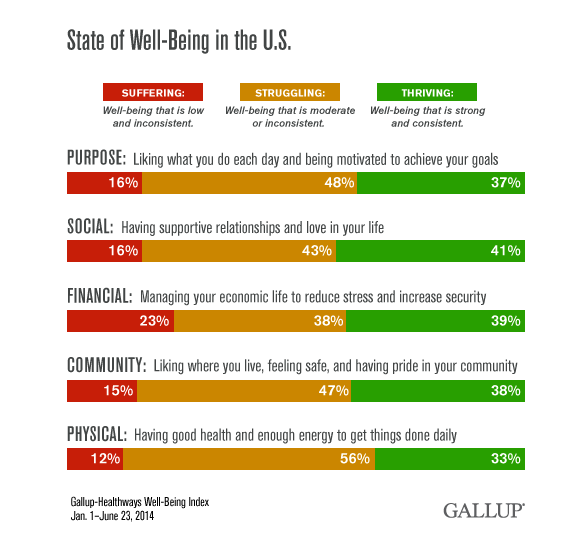WASHINGTON, D.C. -- Americans are most likely to be considered thriving in their social well-being and suffering in their financial well-being across five elements of well-being measured by the newly updated Gallup-Healthways Well-Being Index. In general, more Americans are suffering or struggling than are thriving across all five elements.

Gallup and Healthways, which have partnered to track Americans' well-being since 2008, added 27 new, actionable questions to the Gallup-Healthways Well-Being Index in January 2014. The updated index is organized into five elements of well-being:
- Purpose well-being is composed of questions about having an inspiring leader, daily activity, goals, and strengths.
- Social well-being includes questions about relationships with friends and family, personal time, and received encouragement and support.
- Financial well-being is made up of questions about standard of living, ability to afford basic necessities, and financial worry.
- Community well-being includes questions about community pride, involvement, and safety and security.
- Physical well-being includes questions related to alcohol, drug, and tobacco use; current disease burden and past diagnoses; exercise; and eating habits.
Extensive research by Gallup and Healthways shows that, taken together, these five elements are the core components of the best possible life.
The calculations pertaining to these elements are based on over 80,000 interviews conducted from Jan. 2-June 23, 2014. Gallup classifies respondents, at the element level, as "thriving" (well-being that is strong and consistent), "struggling" (well-being that is moderate or inconsistent), or "suffering" (well-being that is low and inconsistent).
Older Americans, Women, Southerners Are Thriving Across More Elements
Demographic, regional, and other subgroup variations in well-being on these five elements provide a valuable basis for better understanding the nature of well-being in the U.S. and can be instructive in conceiving strategies for improving it.
Well-being differed by age, gender, and geographic region in the first half of 2014, similar to patterns Gallup and Healthways have seen previously. Americans aged 65 or older are more likely than younger adults to be thriving in each of the five elements of well-being. The percentage of women who are thriving eclipsed the percentage of men who are thriving in all elements except financial well-being, where they are about the same.
Southerners have an edge over those living in all other regions in terms of the percent who are thriving in three of the five elements: purpose, social, and community well-being. Westerners are the most likely to thrive in physical well-being. Midwesterners and westerners essentially tie as highest on financial well-being.

Implications
Americans are more likely to be struggling or suffering than thriving across all five elements of well-being, underscoring the significant challenges Americans face in bettering their quality of life. Gallup and Healthways research also shows that half of Americans are thriving in only one well-being element or none at all. And fewer than one in five U.S. adults are thriving in four or five elements, which indicates that many individuals are not maximizing their well-being.
While Americans likely can do more to improve their sense of purpose, social relationships, financial security, connection to community, and physical health, government leaders and employers can do a lot to encourage and support their efforts. Each of the five elements of well-being are interrelated, and working to improve one element can contribute to growth in other areas. For example, an individual or company with strong social well-being might integrate social networks and support into an exercise program aimed at bolstering physical well-being. Companies can integrate personal finance education into their broader wellness programs for employees. And individuals with strong purpose can apply their unique strengths to local volunteer activities, thereby increasing their sense of community.
These efforts to boost individual well-being are critically important to the health of communities, workplaces, and the U.S. economy overall. Previous Gallup research has shown that well-being predicts key health outcomes such as healthcare utilization, life expectancy, new onset disease burden, and change in obesity status. Additionally, the Well-Being Index predicts important business outcomes including absenteeism, turnover, and workplace safety.
Read a related article in the Gallup Business Journal, "What Your Workplace Wellness Programs Are Missing."
Survey Methods
Results are based on telephone interviews conducted as part of the Gallup-Healthways Well-Being Index survey Jan. 1-June 23, 2014, with a random sample of 85,145 adults, aged 18 and older, living in all 50 U.S. states and the District of Columbia.
For results based on the total sample of national adults, the margin of sampling error is ±1 percentage points at the 95% confidence level.
Interviews are conducted with respondents on landline telephones and cellular phones, with interviews conducted in Spanish for respondents who are primarily Spanish-speaking. Each sample of national adults includes a minimum quota of 50% cellphone respondents and 50% landline respondents, with additional minimum quotas by time zone within region. Landline and cellular telephone numbers are selected using random-digit-dial methods. Landline respondents are chosen at random within each household on the basis of which member had the most recent birthday.
Samples are weighted to correct for unequal selection probability, nonresponse, and double coverage of landline and cell users in the two sampling frames. They are also weighted to match the national demographics of gender, age, race, Hispanic ethnicity, education, region, population density, and phone status (cellphone only/landline only/both, and cellphone mostly). Demographic weighting targets are based on the most recent Current Population Survey figures for the aged 18 and older U.S. population. Phone status targets are based on the most recent National Health Interview Survey. Population density targets are based on the most recent U.S. census. All reported margins of sampling error include the computed design effects for weighting.
In addition to sampling error, question wording and practical difficulties in conducting surveys can introduce error or bias into the findings of public opinion polls.
